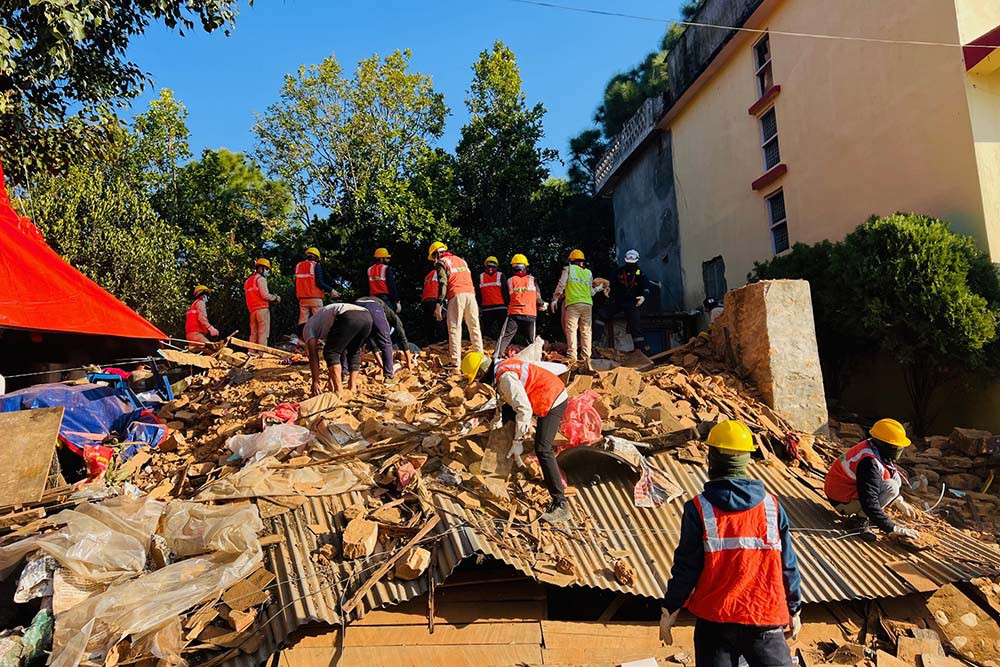
The government has started allocating resources for the Second International Airport (SIA) Nijgadh since fiscal 2007/8. The project identified as a national pride project with the capacity of 15 million passengers a year is explained as transformative and a game changer in the country’s economic development, however moving at a controversial snail pace.
The Kathmandu-Tarai fast track and SIA Nijgadh are integral to each other as the fast track connects Nijgadh Airport with Kathmandu in the shortest distance of just 72.5 kms.
SIA Nijgadh is earmarked as the only possible alternative for Tribhuvan International Airport (TIA). Though the construction of Pokhara Regional International Airport and Gautam Buddha International Airport, Bhairahawa have gathered pace, they cannot be an alternative solution for TIA.
Ambica Shrestha, President of the Nepal Heritage Society and a tourism entrepreneur opines, “SIA Nijgadh will be the only alternative of TIA, the government must expedite the project without much delay as we have lost one decade without doing anything substantial to take the project forward”.
Though the government started allocating budget since fiscal 2007/8, the land acquisition for the international airport, which is the initial ground work, has not been concluded yet. The government has spent seven years in debate whether to buy the detailed feasibility report prepared by the South Korean Company, Landmark Worldwide, or not.
However, the 15th five-year plan (2019/20- 2023/24) of the government has envisioned completing the SIA Nijgadh by 2023/24. Delays in the physical infrastructure is not uncommon in Nepal with prime example of Melamchi Water Supply Project which is considered as the lifeline of the drinking water supply for valley denizens still awaiting completion. SIA Nijgadh is considered a critical project to create robust air connectivity and develop Nepal as a dynamic bridge between two giant economies, India and China. However, lack of vision, capacity and execution has been plaguing the growth of the project.
Also environmental concerns loom large with huge forest areas having to be cleared to allow the project to go forward. Out of the 8,045.8 hectares of land, the proposed airport would require deforestation of 2.4 million trees. As per the Environment and Social Impact Assessment (ESIA) report, around 770,000 trees will be chopped down during the first phase with construction being carried out on 2,500 hectares. Late Minister of Culture, Tourism and Cvial Aviation, Rabindra Adhikari had proposed expansion based on need in the future.
Environment activists have criticised the government on lack of scientific study going into this project. Citing the examples of the busy airports like London Heathrow and Chhatrapati Shivaji in Mumbai, activists have pointed out that the current airport TIA is not working to full capacity and raised questions on the need for another international airport.
Newly appointed Culture, Tourism and Civil Aviation Minister Yogesh Bhattarai - in a controversial public speech - has said he will lay the foundation stone of the Nijgadh airport in the near future whatever the opposition to the project.
The government is not clear about the construction modality of the project. Minister Bhattarai has said that the government can develop the project allocating needful resources from the fiscal budget every year during the construction period as the Nijgadh airport will be multi-year project.
The Minister’s opinion contradicts with the earlier move of the government to seek investment to build the project as the project was showcased at the Investment Summit organised on March 29-30 this year. According to Maha Prasad Adhikari, CEO of the Investment Board Nepal (IBN), five foreign companies were found eligible among those who expressed interest to develop the Nijgadh International Airport. Indian, Swiss, French and two Chinese firms had expressed interest to develop the airport. The airport project was set to be awarded through competitive bidding among them, as per IBN.
Initial estimation show the project cost will hover around USD 3 billion. The government has not yet made clear whether the airport project will be developed under public-private partnership or financed by the government as opined by Minister Bhattarai.
Of the five firms who have expressed interest to develop the airport are two state owned firms from China - China State Construction Engineering and China Airport Construction. Similarly, GMR India, which is going to develop 900 megawatt Upper Karnali Hydel Project has also expressed interest to build airport project, according to IBN. GMR has developed the Indira Gandhi International Airport in Indian Capital. GMR is operating this airport. The other two firms are Zurich Airport AG of Switzerland and Vinci Airport of France. The state-owned Zurich Airport AG has been operating Zurich Airport. It has also been operating airports in other countries as well. Similarly, Vinci Airport is also an experienced company, which has been operating a dozen airports in France, five in United States of America, 10 in Portugal, three in Japan under BOOT model.
Shanta Raj Subedi, former Finance Secretary has said that the government should develop a Special Purpose Vehicle first which is the legal entity that undertakes a project. All contractual agreements between various parties are negotiated with the SPV. “Laying the foundation stone is not sufficient to take forward a project,” said Subedi, “After finalising the SPV, the government should carryout the EIA (Environmental Impact Assessment) to develop the airport with minimum loss of trees as the project site is considered a habitat for various wildlife including tigers.”
The Environment and Social Impact Assessment (ESIA) rendered for the SIA Nijgadh is reportedly copied from the EIA report of a hydel project and is misleading. According to Engineer Om Sharma, Project Chief of SIA Nijgadh, the first phase construction works of the SIA Nijgadh can be carried out chopping down only 4,000 trees.
But the key question remains, is another international airport really required? And if yes, where is this spike of international air travel coming into Nepal from? Are the capacity issues at TIA a reality or is it simple mismanagement? The SIA Nijgadh and the fast track compel one to think of the displacement of communities, the cutting down of vast forest areas and the harm to wildlife. In addition is the question of air routes that are yet to be negotiated with India. Maybe some clarity from the government would help the public understand the situation better.





